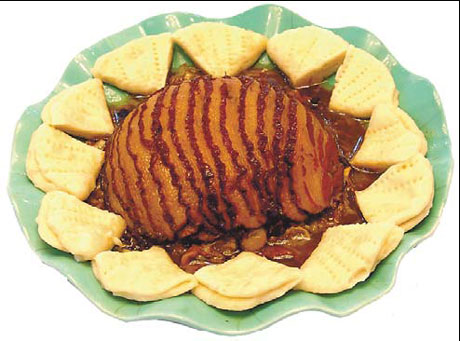Life
Home sweet home
By Qin Zhongwei (China Daily)
Updated: 2010-05-03 14:59
 |
Large Medium Small |
One might assume food critics are all fond of dining out, but for Eileen Wen Mooney, the Beijing-based food writer and columnist, home cooking is her sweetest choice. Her kitchen - loaded with jars of herbs and spices from around the world - paints the picture of someone who is not only good at sampling food, but also enjoys the preparation process.

Recent food scandals like hogwash oil just reinforce her desire to teach food lovers how to eat safely and cook wonderfully.
"It is different," she said, when comparing dining out and cooking at home.
"If you go to a five-star hotel or a fancy restaurant, you might think it is okay. But that feeling doesn't last forever.
"Home cooking is both enjoyable and rewarding. It gives one a sense of accomplishment."
Mooney, who moved to Beijing in 1994, is known for her mouthwatering reviews in The Beijinger, Timeout Beijing, City Weekend and The Guardian.
Mooney published an English book, Beijing Eats, last year that was considered by many as a must-read bible for anyone wanting an authentic Chinese meal in this city.
Last month, the top chef launched a cook course called Eileen Cooks, which takes place at her Beijing kitchen to anyone interested in home cooking.
During the class, Mooney tries to teach expats typical Chinese food such as spring rolls and Kungpao chicken, and to show how to use an oven to make Western bakeries, pizza and tiramisu to Chinese learners.
The book and cooking programs are the result of 16 years of research in authentic Chinese food in Beijing, "from street stalls to small hutong eateries and to posh contemporary restaurants".
Her discovery of typical local food includes talks with experienced chefs and a collection of rare recipes.
Mooney's passion for Chinese food comes from her mother, a Hakka native of Meixian county, Guangdong province.
Growing up in Bali, Indonesia, Mooney's childhood memories are of her mother cooking with soy sauce, eggs, cassava starch and white pepper to make meatballs. Mooney said she loved helping her mother wrap zongzi, a traditional food used to celebrate the Dragon Boat Festival.
Her Hakka influence continues today with her signature dish being meicai kourou, a typical Hakka food learned from her mother.
In the late 1970s, Mooney moved to a high school in Taipei where she discovered non-Hakka dishes for the first time, like Mapo Doufu taught by Fu Peimei, one of the island's most famous female chefs.
Following that, when she lived in New York from 1977 to 1985, her sister-in-law taught Mooney how to cook Italian food that included lasagna, manicotti, eggplant parmesan and various pasta sauces.
But her widespread knowledge has made the food writer critical of anyone who views Beijing as an international culinary city.
It is not a "melting pot" in any real sense, since many ingredients are not easily available, she said.
"For example, I cannot cook Indonesian food here because some of the important ingredients are still unavailable."
She said a lack of ingredients is pushing new restaurants to do simple things like add spice to dishes, or opt out for fusion dishes that don't always work for Chinese cuisine.
"It is more and more difficult to find something original. Beijing restaurants selling good quality zhajiangmian are extremely rare now," she said.

Recipe | Meicai Kourou
Ingredients
1 piece of pork belly
1 tbsp light soy sauce
1 tbsp dark soy sauce
1 cup minced mustard leaves
1 tbsp light soy sauce
1 tbsp rice wine
Oil
Salt
11 steps to make authentic meicai kourou from Eileen
1. Select a piece of pork belly that has layers of lean meat, fat and skin intact, about 3.5 inches wide.
2. Boil the meat in simmering water until it is easily pierced with a chopstick or bamboo skewer. Note: discard the first pot of water to eliminate impurities.
3. Remove the meat from the pot and drain it in a strainer. Brush the skin with a combination of both light and dark soy sauce when it is still hot. Rub the meat with salt. Set aside to cool and dry.
4. Add a pinch of sugar to any remaining soy sauce, discarded after brushing the skin, and marinate the minced mustard leaves (pre-soaked in cold water) in it.
5. Heat some oil in a deep pot to deep-fry the skin until bubbly. Remove, drain and let cool.
6. Slice the pork belly into about pieces about half an inch wide.
7. Return these slices to the frying pan and fry slowly on both sides to remove excess fat.
8. Keep a little fat in the frying pan and continue to saute for a few minutes by adding light soy sauce and rice wine (one tablespoon each). Remove the pieces of meat from the frying pan.
9. Put the minced mustard leaves into the frying pan. Stir-fry for a few minutes until the aroma of the leaves comes out, and then scoop out.
10. Arrange the sliced meat so the skin side touches the bottom of the bowl, and then top with the minced mustard leaves.
11. Put the bowl into a steamer for at least half an hour. You will know when the dish is ready when the infusion of green mustard leaves, fatty pork and the simple seasoning of rice wine and soy sauce fills your kitchen.
Food notes:
My mom, who was born in a small village in Meixian, a center of Hakka culture, taught me her secret recipe for beautiful kourou that is not only tasty but also has an amazing aroma. This dish is absolutely mouthwatering.
The key is to brush the skin with soy sauce immediately after boiling the meat, giving a nice caramelized color.







